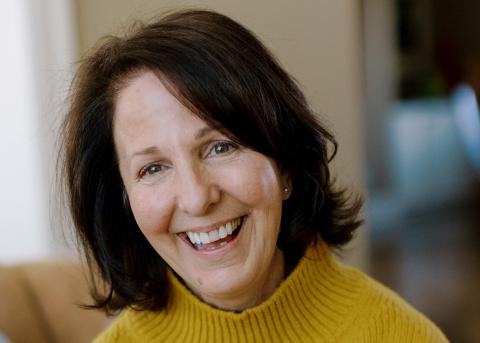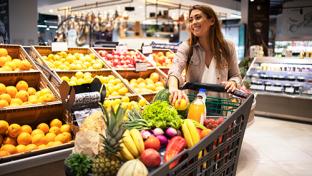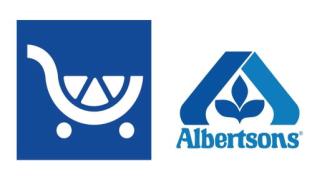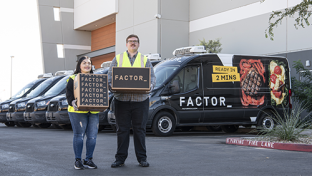EXCLUSIVE: Albertsons Ushers in New Era of Retail Media

Retail media spend is project to eclipse $50 billion in 2023 as retailers become offer platforms for engaging with shoppers. In June Albertsons Cos., which launched its retail media network Albertsons Media Collective in 2021, debuted a standardization framework to improve transparency in retail media and remove points of friction for advertisers. Progressive Grocer spoke recently with the architect of that framework, Albertsons Cos.' SVP of Retail Media Kristi Argyilan, about what’s next for retail media, the new age of transparency and the omni grocery shopper.
Progressive Grocer: How would you describe the retail media environment in grocery right now?
Kristi Argyilan: The environment is incredibly favorable for retail media. It doesn't take much to pick up one of the media trades and see that we're expected to be one of two rapidly growing media sectors. The other one being connected TV. And the thing that's especially intriguing about grocers in the retail media space is that we see our customers probably more frequently than most of the other retailers. Think of your own personal experience: You're in the grocery store at least two times a week. We see our best customers two and a half times a week, so we have a lot of frequency opportunity to engage with them on an ongoing basis. This means we also have more data points, because we have an opportunity to see more of their shopping behaviors, including the big and little shopping trips that they do. It gives us a lot of insight into their lives in general.
PG: How have the traditional spending buckets (consumer, trade and shopper marketing) evolved over the past few years, from pre-pandemic to now? What about over the course of your career?
KA: There are a couple of what I would call keynote moments for retail media. The first big one that I recall, and this was when I was at Target running Roundel, was when Amazon started to release more of the financial information on their advertising business. And that gave retailers an opportunity to really see what kind of value creation these retail media businesses generate for retailers and reinvest in their business so they can keep up with the changing needs of their customers, which is what we saw in warp speed during the pandemic as everyone started to shop very differently. They shopped, I won't call it digitally, but digital became part of how they shopped. A lot of pre-shopping, a lot of pick up and go, and ordering in advance.
Those behavioral changes have stuck since the pandemic because it unlocked the convenience shopping that everyone is looking for. If they don't have that day where they can wander up and down the aisles and see what's new and fresh and interesting, being able to use digital tools, to be able to shop differently is a key component of it. And so once again, that just gives us as a digital media business more opportunities to engage with customers as they're planning how their day is going to go.
PG: Do you think that retailers can eventually take the place of traditional media? Especially with what's going on with connected TV?
KA: We're doing a lot with connected TV. We're actually doing a pilot right now with OMG [Omnicom Media Group] on linear TV. And a lot of that is because, if you think of how well retailers know their customers, and I like to call them real people doing real things, we have a lot of ability with our first-party data to bring a much more interesting data source to the media industry. And any one of us, especially the top five or six of us, we know at least half of the U.S. adult consumer population, and there aren't many media companies that can say that. So do we displace any of the big ones? No. Do we take a little bit of their share? Absolutely. And I think that we'll know more once cookies actually start to come out of the marketplace, how much more stable and significant the data component of our business is versus the competition.
PG: In November it will be two years since Albertsons launched the Albertsons Media Collective. Talk about your key initiatives and projects in the works.
KA: We have been rapidly expanding the business over a really short time horizon, so it has not been an easy lift. A lot of the biggest retail media networks had been doing some version of shopper marketing for a very long time. For us to take ownership of that back and to build the in-house capability has been really quite exciting work, but not a light lift by any means. The business is growing according to plan and we are returning back to the company what we intended to bring back to the company. Again, so that Albertsons can continue to evolve to keep up with customer changing behaviors.
[Read more: "Progressive Grocer Welcomes Albertsons’ Sustainability Chief to Grocery Impact Event"]
We are doing really great foundational work, working with the Trade Desk and Google and the big platform companies including Criteo and CitrusAd. We're also doing really interesting pilots with Pinterest and OMG. I like to call it a foundation of stone and a place in the clouds, straddling both at the same time so that we continue to stay fresh as the marketplace changes rapidly.
PG: Okay let’s talk about those pesky ever-changing consumer shopping behaviors. How are you seeing the Albertsons customer behaving now?
KA: We're seeing consumers actually start their relationship with Albertsons in all different ways. Some of them are starting it through a shopping occasion with Instacart, when they just need to get some things in the house fast. Some of them might be coming in through our pharmacy and then discovering the food side of the house when they go through the pharmacy. We are definitely seeing different shopping occasions across all consumer groups. So you know how we used to do segmentation and you would say, "This shopper does this"? Well, we are all shopping differently, but just in different variations. And so our ability to have an app that supports shopping behaviors is a real key component and a lot of the work that we've been doing recently as an enterprise.
PG: Talk to me about how the standardization conversation got started at Albertsons and how you developed the framework.
KA: One of the things that I love about my job and about the Albertsons Media Collective in particular is that I report directly to [Albertsons Companies’ CEO] Vivek [Sankaran]. He is very engaged in the business and we have something that we call a Client Council, where we pull a small group of clients together to get input from them on what's working and what isn't category-wise, but also specifically to us. And so we're starting to get a lot of feedback from them that every retail media network is a snowflake. It's really hard to understand how to compare one to the other and talk about how retail media is performing. We also did a trip through CES, and one client after another would tell us about the need for retail media networks to be more similar because it's too complex to engage with us.
To take the friction out of the category, we brought McKinsey on board to help us create the standardization framework that is intended to be the starting point for the industry conversation that we need to have about where we can be similar and where we should be different. What can we put a pin in today and have it be the pin forever versus things that'll change over time as we mature as a category. It is creating this really great dialogue and debate in the retail media space so that we can start to set these standards so brands know what to expect from us.
We also need to have a conversation around transparency to understand why one retail media network may operate differently than the standard. From there, brands can decide if that's something that they're comfortable with or not.
PG: How have your relationships with brands evolved in the past couple of years as retail media has exploded?
KA: What we're seeing is that brands are investing more heavily in retail media. It is especially recession-proof because it's performance media and it's about driving sales and a business outcome. You will see debate over how something performed, because if something isn't executed all the way through at the store level, you may not get the same return on ad spend as you would if everything's hitting on all cylinders. So that gets into distribution, supply chain and some of the other things that are challenges for retail. But I find almost every one of the brands that we work with to be incredibly supportive and engaging with us in the spirit of partnership. Because they know if they do that, we as a retailer represent a huge growth opportunity for them. They want to co-create because they know it's a growth lever for them as well.
PG: Are there things that you think your competitors do better than Albertsons, or that you do better than your competitors?
KA: I think that we all have different flavors, going back to being snowflakes. We have similar flavors to the same things. One of the things that I really appreciate about where we are in our life stage is what we call our late-mover advantage. Many of us on our executive team have already done at least one retail media network somewhere else. We have really great learnings that we can apply to the decisions we make. Today there's a different partner ecosystem so we can bring more of a variety of partners in. Our data and the infrastructure that Albertsons has built is reasonably new and fresh. So we've got the most modern computing power and data storage solutions at Albertsons Cos., which is better for Albertsons Media Collective in general.
The one thing I'll say about Walmart, Target, Lowe's and Kroger, is they've been around for a while so they have stable, mature machines that are fueling their retail businesses and the retail media businesses. I wish we had that kind of history, but we don't. But we also use the lack of history to our advantage because we don't have any legacy systems, or “Frankenstacks,” as I like to call them, that we have to operate off of because everything at Albertsons is reasonably new.
PG: How are you thinking about scaling retail media in-store, things like digital shelf edge displays and such.
KA: We do a ton of experimentation in that space. The issue is there’s a lack of companies to help us scale it. There are smaller regional or just niche players but no one that can just come in up over the top and say, "Here is the operating system for digital media in your store." Which I think is going to be a huge opportunity. There are some companies starting to emerge now, but they're just not proven yet.
[Read more: "What's New in Supermarket Shelf Technology"]
PG: Wow. Big opportunity there.
KA: Yes, we are currently working with all of our division presidents to get the list of all the things that they've got installed in their stores, to try to figure out where there is scale that we can bring to market. Because there's absolutely a ton of demand. Think of the number of consumers that go through all the retailers in the country, especially the big ones, and the opportunity to turn those into appropriate media channels. That doesn't mean we want Times Square in every retail outlet, but we do want to get to a place where we tastefully enhance the customer experience with the right messaging, given where they are at that point in time in the store.
PG: Okay Kristi, any predictions for the retail media space in grocery over the one to three years?
KA: I think that we will get to a place where we drop the retail part of this or create better balance from retail to media. A pivotal moment will be when cookies start to come out of the marketplace and a lot of the data pools that marketers have been using start to lose their validity. We will be a bigger player in that space.
I also see an opportunity for retail media to play a big role in television by bringing better quality data to measuring how television performs. So it won't just be, did you get the impressions and the eyeballs, as we've always called it. It's, did that TV campaign actually drive sales? And to be able to answer it in a closed- loop, faster way versus some of the marketing mix modeling that can take a long time, will allow marketers to think about television in real time, the same way that they do with digital.
Boise, Idaho-based Albertsons operates more than 2,200 retail stores in 34 states. The company is No. 9 on The PG 100, Progressive Grocer’s 2023 list of top food and consumables retailers in North America. PG also named the company as one of its Retailers of the Century.





